On His Knees
Apr 2, 2014
 On his knees all day long, making the city a better place.
On his knees all day long, making the city a better place.
Apr 2, 2014
 On his knees all day long, making the city a better place.
On his knees all day long, making the city a better place.
Apr 4, 2014
 Washington, DC, travel agent and blogger Jean Newman Glock had an hour to kill the other day and a brand new cellphone camera with which to kill it. So, perhaps to model good behavior for her tourist-clients, she headed straight for the National Gallery of Art and pointed her new Nokia at some four-hundred-year-old paintings.
Washington, DC, travel agent and blogger Jean Newman Glock had an hour to kill the other day and a brand new cellphone camera with which to kill it. So, perhaps to model good behavior for her tourist-clients, she headed straight for the National Gallery of Art and pointed her new Nokia at some four-hundred-year-old paintings.
The photos she snapped and published in her blog include this snuffed-out candle, a detail from a 1635 still life, "Banquet With Mince Pie," by the Dutch painter Willem Claesz Heda. "So many theories can be created," notes Glock, "about this hastily ended feast at an obviously wealthy household."
The trip to the museum apparently left Glock with some long thoughts, as illustrated by the candle gone dark: musings about the brevity of life and the irrelevance of earthly possessions (with the possible exception of that new Nokia Lumia Icon camera with its 22-megapixel sensor and easy upload to WordPress via tablet).
Glock didn't come to her philosophical insights all by herself; she experienced the art that afternoon as part of a National Gallery tour on the theme of "Glimpses of Seventeenth Century Life." Leading the tour was someone Glock describes as "the amazing scholar and docent Sandra Horowitz."
That amazing scholar and docent, Sandra Horowitz, is my mom. I'm busting my buttons here.
Apr 8, 2014
 Lots of weather delays Sunday at the Birmingham airport.
Lots of weather delays Sunday at the Birmingham airport.
Apr 9, 2014
 You may be surprised to realize just how few degrees of separation there are between you, sitting wherever you are sitting, squinting at these words on your screen, and a live chicken riding quietly in an overcrowded minibus along the bad, rutted roads of north central Zambia.
You may be surprised to realize just how few degrees of separation there are between you, sitting wherever you are sitting, squinting at these words on your screen, and a live chicken riding quietly in an overcrowded minibus along the bad, rutted roads of north central Zambia.
Not only that, there’s a lot more to the connection between you and that chicken than dinner on a plate.
We could say the relationship weaves across oceans, connecting family, work, school, friendship, culture, hospitality, and a whole lot else.
It goes like this: a young Zambian man named Chungu Mwila left his home and family to come to America, where he is now a student at the University of Southern Maine in Portland. A friend of his in Maine, Alain Nkulu, is also a friend and colleague of Sue Stein, who works at Portland’s Waynflete School with foreign-born students, immigrants and refugees from many countries in Africa and other distant lands.
Now it just so happens that Sue Stein is a friend of these Good Mornings, as well as, um, a Stein and a Mainer, so there you are. And as of this writing, she is in Africa herself, visiting the homelands, friends, and families of many of her students and former students.
Before Sue left Maine for her travels, after Alain Nkulu had put her in touch with Chungu Mwila, Chungu provided her with contact information for his sister Yvonne, who still lived in Zambia, in the Matero district of Lusaka, the capital city.
In Lusaka last month, Sue looked up Yvonne, and the two of them decided to become traveling buddies for a bus trip into Zambia’s Copperbelt region, some 370 kilometers north of the capital, near the border of the Democratic Republic of Congo. They planned two stops in the Copperbelt: first, to visit Yvonne and Chungu’s Uncle Charles and Aunt Bana Mpundu, who live in the bush outside the town of Kalulushi, and then to drop in on Yvonne’s 18-year-old daughter, Loveness, who attends Chikola Secondary School in Chingola, another 50 kilometers down the road.
Uncle Charles and Aunt Bana grow their own lemons and mangoes and, of course, raise their own chickens. They make their own rope, from the fibers of tree bark. For the last twenty years, ever since Charles was laid off from the mines with just enough severance pay to pay off their hut, they’ve had to scrape by with no money at all, except from occasional sales of fruit and vegetables.
Nonetheless, when it came time for Yvonne and Sue to press onward with preparations for the continuation of their journey, Sue noticed that Aunt Bana had caught one of her chickens. Communication was limited, but she was pretty sure that Bana referred to it as “your chicken.”
Even so, it was not until Yvonne and Sue were waiting at the bus stop–a store in Kalulushi–that Sue first realized Yvonne was carrying the chicken, which had plastic bags tied around its rear end.
“Just you wait, Sue,” her students had told her back in Maine. “Wait till you are on those buses with people bringing all those animals.”
And there she was, in Kalulushi, Zambia, getting on a bus–a minivan, actually, the usual kind of vehicle–way overcrowded with people and luggage and a single chicken. Just one chicken, and it was hers and Yvonne’s; she had herself become exactly the person her students had told her she’d find in Africa.
The chicken was very well-behaved, Sue reports, quiet and still through two bus rides. The plastic “diaper” served its purpose.
They eventually handed the chicken over to a woman named Sharon, in whose house Yvonne’s daughter Loveness was living while at school. Sharon set the bird down on the floor in a corner, where it rested quietly, its feet tied together.
They spent the afternoon at Loveness’s school, then returned to Sharon’s house, where the chicken was still there on the floor, not doing much of anything. “At times I thought it was dead,” says Sue. “Nobody was paying it any attention at all.”
They ate dinner. Loveness and her friends danced for the guests. Finally, around 9 o’clock at night, Sharon picked up a knife and the chicken. Sue caught her eye and gestured with a finger across her throat. Is that what’s about to happen? Sharon smiled.
She came back inside with a headless chicken.
“She had been at work all day, and then taking care of her baby,” Sue says. “And she was still wearing what even my daughters would call stylish clothes.” There was water boiling on the charcoal brazier; her 18-month-old son Junior was toddling in and out, between her legs and the coals and the boiling water.
Sharon dipped the chicken in the pot, pulled it out, and spent the next hour plucking its feathers.
And Sue got back on the bus, headed back to Lusaka and then on to Rwanda and Burundi. In Burundi, she reports, they have zumba classes.
Apr 10, 2014
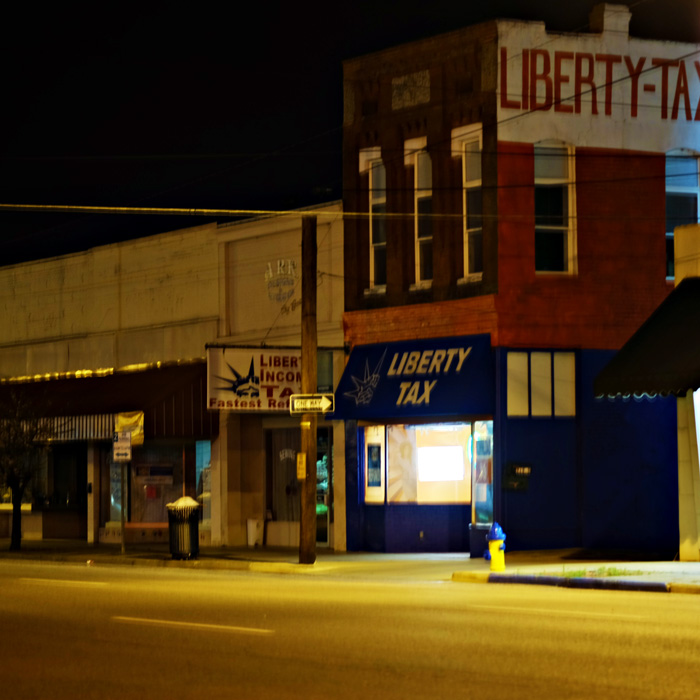 By eleven o'clock on a Friday night, the streets of downtown Bessemer, Alabama, are empty, and the town looks dead. Even the Bright Star Restaurant is closed for the night.
By eleven o'clock on a Friday night, the streets of downtown Bessemer, Alabama, are empty, and the town looks dead. Even the Bright Star Restaurant is closed for the night.
The only thing open, it seems, at least on this block of 19th Street in Bessemer, is the office of Liberty Tax preparers. Wonder why the folks in there are burning the midnight oil?
Apr 11, 2014
 This spring-break picture of Hank at the summit of the Stolen Chimney, a corkscrew spire atop the Ancient Art rockwall near Moab, Utah, has already been on Facebook, where it attracted a few comments. The award for Best Comment goes to Hank's Uncle Bob: "Get down from there this instant!"
This spring-break picture of Hank at the summit of the Stolen Chimney, a corkscrew spire atop the Ancient Art rockwall near Moab, Utah, has already been on Facebook, where it attracted a few comments. The award for Best Comment goes to Hank's Uncle Bob: "Get down from there this instant!"
Apr 12, 2014
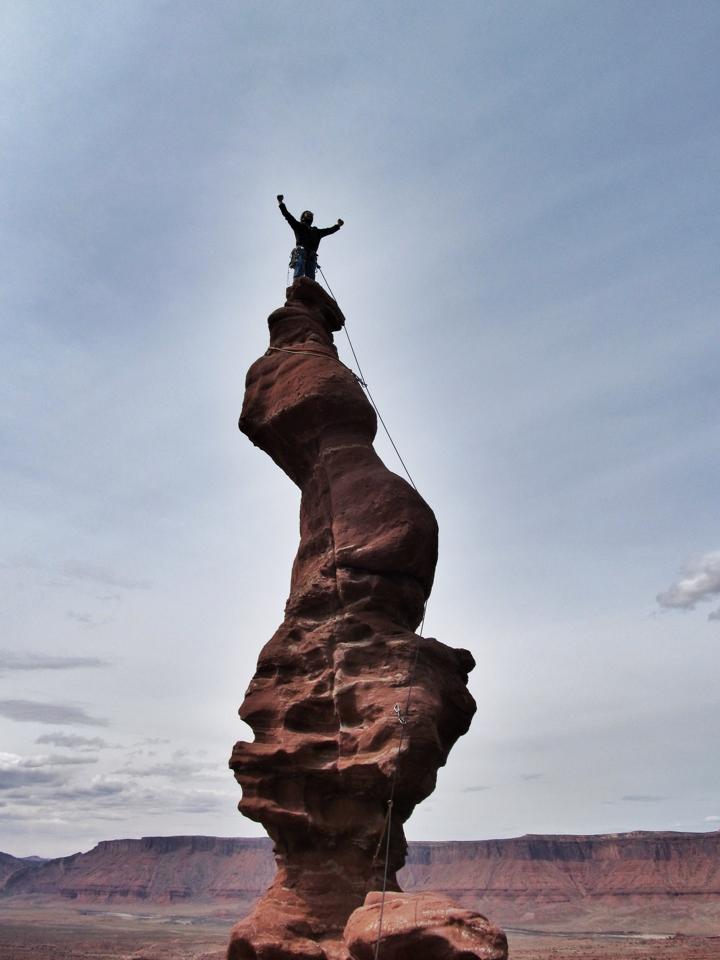 Looks like yesterday's g'mornin was one silly mess: wrong boy, and even wrong uncle.
Looks like yesterday's g'mornin was one silly mess: wrong boy, and even wrong uncle.
This picture shows the real Hank Stein atop the twisted chimney at Ancient Art near Moab, Utah. Yesterday's picture was of some other somebody.
And the uncle who gave him a sort of shout out on Facebook–"Get down from there this instant!" That was his Uncle Rich. Yesterday's posting attributed those immortal words to some other uncle.
Apologies all around.
Apr 20, 2014

'Twas the night before Easter, and all over town, stuff was getting weird. Above, Chicago; below, Philly.
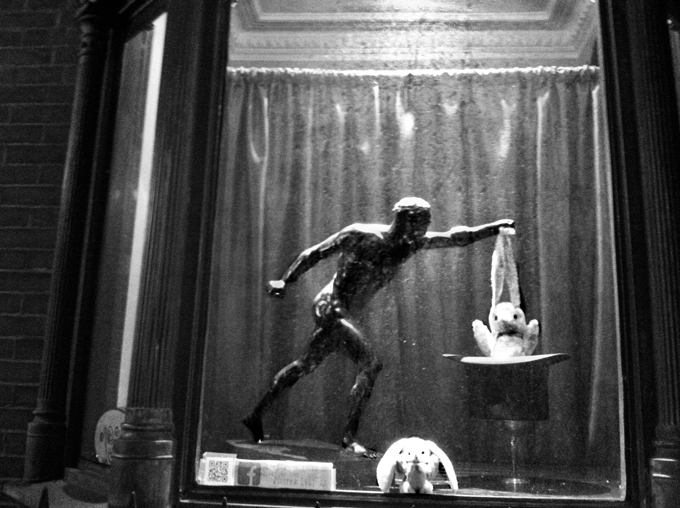
Apr 21, 2014
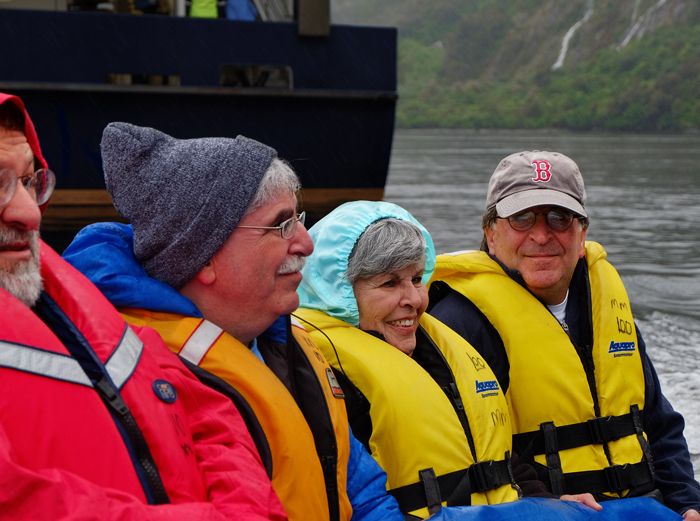 Here in a Zodiac, scooting across Milford Sound, a fjord on New Zealand's remote southwest coast, on a cold wet summer day this past December, is Helen Ruskin Stein Behr with her three sons. Not pictured is her daughter, who visited Milford Sound a few days earlier.
Here in a Zodiac, scooting across Milford Sound, a fjord on New Zealand's remote southwest coast, on a cold wet summer day this past December, is Helen Ruskin Stein Behr with her three sons. Not pictured is her daughter, who visited Milford Sound a few days earlier.
The impetus for the journey to New Zealand was the awesome wedding of one of the granddaughters, Gillian, who emigrated to New Zealand seven years ago with her parents, Richard and Arleigh, and her sister Avi.
Today is Helen's birthday, as she turns eighty-something-and-who's-counting, to our great joy. Wishing her many happy returns of the day.
Apr 23, 2014
 Up the road a ways past Casablanca in Morocco is the ancient Berber city of Marrakech, famed for its gardens and palaces and especially for its sprawling, labyrinthine markets.
Up the road a ways past Casablanca in Morocco is the ancient Berber city of Marrakech, famed for its gardens and palaces and especially for its sprawling, labyrinthine markets.
Click on the picture to, um, biggenize it, to glimpse what's on display in this souk and also, perhaps, to check the accuracy of our unofficial count: mounted on rooftops visible here are at least 104 satellite dishes.
Apr 25, 2014
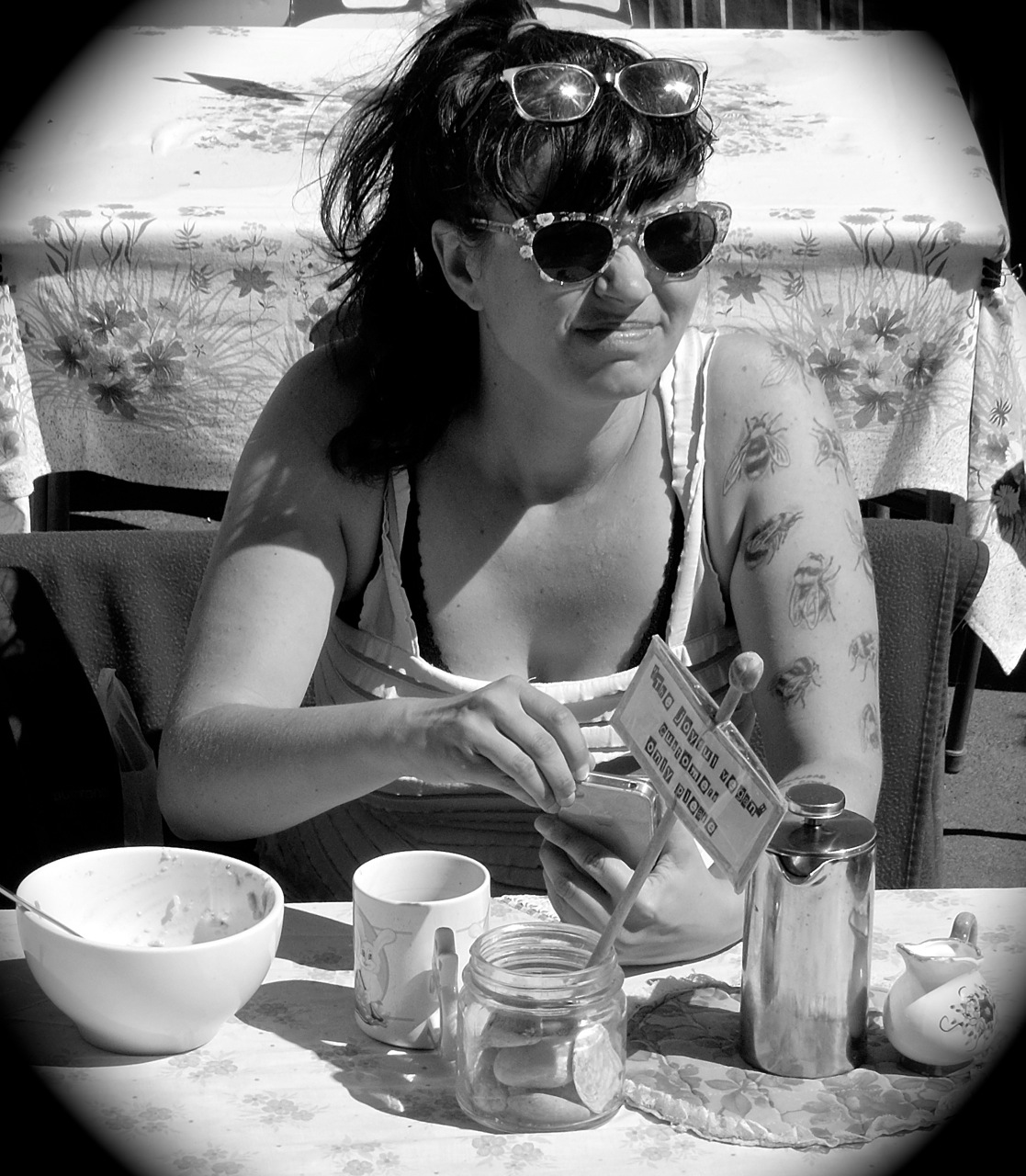 Looks like she's finished her lunch at the Joyful Vegan booth in the Saturday farmers' market next to the train station in Dunedin, New Zealand.
Looks like she's finished her lunch at the Joyful Vegan booth in the Saturday farmers' market next to the train station in Dunedin, New Zealand.
The bumblebees on her left arm raise some interesting issues. Are they about honey and sweetness? Or stinging and pain? Or flight? Or queens or flowers or buzzing or hives?
Apr 26, 2014
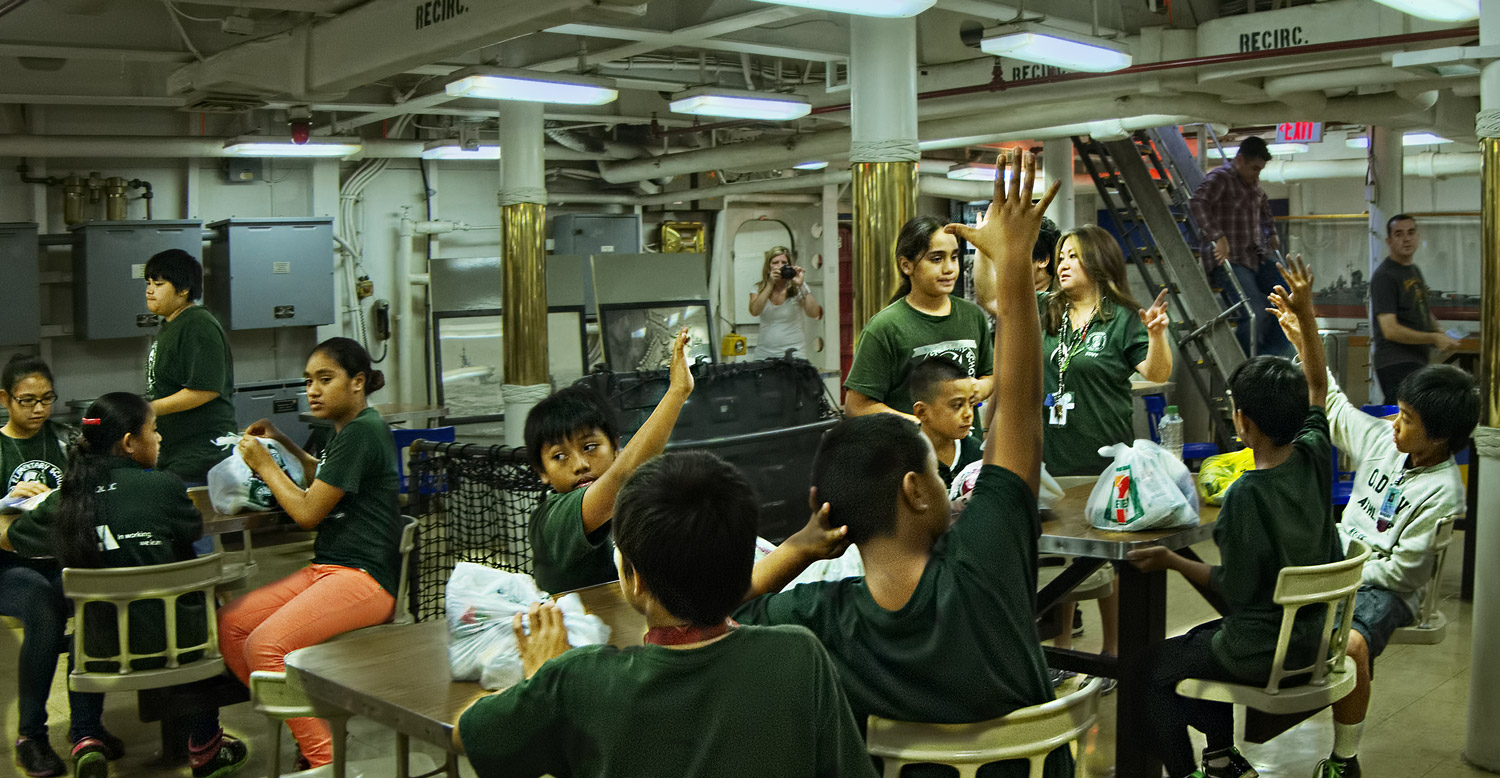 Some of the middle school students participating in their class field trip to the battleship USS Missouri in Pearl Harbor, Hawaii, appear enthusiastically prepared to answer their teacher's question. Of course the question might be: Who's ready for lunch?
Some of the middle school students participating in their class field trip to the battleship USS Missouri in Pearl Harbor, Hawaii, appear enthusiastically prepared to answer their teacher's question. Of course the question might be: Who's ready for lunch?
The students are seated in one of several mess halls deep in the ship; several ladders above them is the deck where the Japanese surrendered on September 2, 1945, to Gen. Douglas MacArthur and representatives of all the Allied powers, finally ending World War II. The American flag flown that day at the ceremony had only 31 stars and was hung backwards, stars at upper right; it was the original flag brought to Tokyo by Admiral Perry in 1853 when Japan was first opened to international trade, and it had frayed so badly over the years that one side of it–the right side–was sewed over with a protective linen covering, leaving only the reverse side for display.
Just below the deck where the ceremony took place is a dented spot in the hull. Six months before the surrender, during the bombardment of Okinawa, a kamikaze pilot had crashed into the Missouri, losing a wing off his plane and starting a gasoline fire aboard ship. The fire was quickly put out, and the ship was only dinged, not seriously damaged; the pilot, however, did not survive. The story is that the Missouri's captain, William Callaghan, had to rescue the pilot's corpse from sailors attempting to summarily dispose of it; Captain Callahan insisted on a full funeral service for the pilot, with military honors and burial at sea. The dent in the hull was never repaired.
After World War II, President Truman decommissioned every other battleship in the navy but insisted on maintaining the Missouri in active service, over the objections of military advisors. Battleships had no role to play in postwar navy planning. The Missouri was sent to Korea, however, during that conflict. It was then mothballed–but returned to duty one last time in 1984 during President Reagan's military buildup. It provided artillery support during the First Gulf War before being finally deactivated.
Since 1998, the Missouri has been a major tourist attraction at Pearl Harbor, as well as a school field trip destination. And there's plenty on board for the schoolchildren to see: big guns, tall stacks of bunks, signs insisting on short showers while at sea, and, of course, the backwards flag and the dent in the hull.
Up top, on deck underneath some of those big guns, a few members of the Marine Band entertained the tourists. The day we and the middle schoolers visited, the band played "Jingle Bell Rock," but now that it's springtime, the setlist has probably changed.
Apr 28, 2014
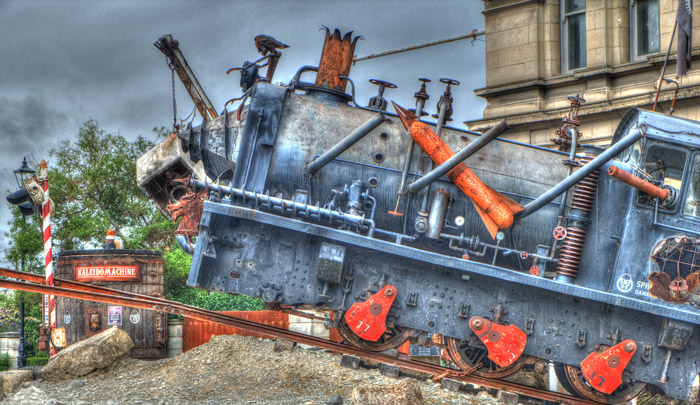 Three hours south of Christchurch on the east coast of New Zealand's South Island is Oamaru, one of the country's oldest cities and briefly–back in the 1870s–one of its wealthiest and fastest growing.
Three hours south of Christchurch on the east coast of New Zealand's South Island is Oamaru, one of the country's oldest cities and briefly–back in the 1870s–one of its wealthiest and fastest growing.
There was a halfway decent harbor for a port to serve the thriving agricultural region, especially after introduction of refrigerated transport for meat. High-quality limestone for building was locally plentiful. A 50-km-long aqueduct was constructed to slake the thirst of the booming little city and irrigate surrounding farmland with fresh mountain water. Industry emerged, lapping up the new water supply. The city built an opera house, an athaeneum, and a large and ornate public garden.
By the 1880s, when economic depression hit hard, Oamaru was said to be "the best built and most mortgaged town in Australasia." The aqueduct went bankrupt, the port closed, industry languished, and construction stopped for more than a hundred years.
What finally saved Oamaru was steampunk, the style of art and/or life that emerged from the punk rock era but is rooted in Victorian-era visions of a fantastic feature: think Jules Verne and H. G. Wells. Steampunk science fiction is inspired by nineteenth-century steam-powered technology and decorative arts, ratcheted up by twenty-first-century irreverence and intensity.
Oamaru's intact nineteenth-century downtown–intact because nobody since the nineteenth century had thought the place worth a dime of investment–created an ideal backdrop for steampunk festivals, steampunk artists' studios, steampunk shopping, and eventually steampunk tourism.
(Oamaru also has penguins, more of which soon. Watch this space.)